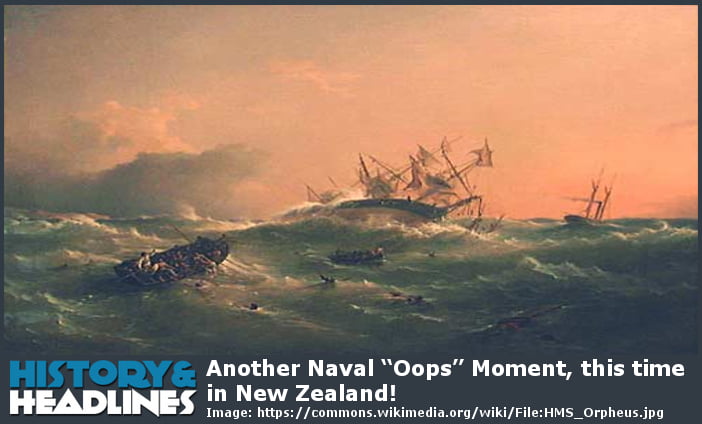A Brief History
On February 7, 1863, the waters off New Zealand witnessed the worst maritime disaster in that country’s history when the Royal Navy corvette, HMS Orpheus went aground and sank while trying to enter Manukau Harbour, leaving 189 of the 259 man crew dead. We have discussed numerous naval and maritime “oops moments” in which blunders have sunk or heavily damaged ships, often with the cost of many lives.
Digging Deeper
The Orpheus was fitted out as a “full rigged ship,” although she also had a steam engine that powered a single screw drive (propeller). Classed as a “corvette,” she boasted 20 muzzle loading 8 inch bore cannons in a “broadside” arrangement, with 10 guns firing off each side. A swivel mount bow chaser 7 inch bore breech loading cannon rounded out the armament. Capable of 11 knots, she was crewed by 259 officers and men. Stretching 225 feet long and spanning a beam of 40 feet, the ship displaced 2365 tons.
Entering service in 1861, Orpheus was the premier ship in the Australia-New Zealand Stations, and as such was the flagship of Commodore William Farquharson Burnett, the senior British naval officer in the area. The ship’s captain was Captain Robert Heron Burton. The mission of the men and the ship was to deliver supplies and troops to land forces engaged in the New Zealand Wars, a conflict between British colonial forces and native Maori people of New Zealand.
Nearing land and entering harbors in far off lands is tricky business. Pilots of ships must rely on either accurate charts or the experience of sailors that have experience with the area. The Orpheus was equipped with charts, both older documents (from 1936 and 1856) as well as the latest chart, produced in 1861. The man steering the ship, Sailing Master William Strong, was as may be expected using the latest chart. As naval big wigs are prone to do, the Commodore overruled the Sailing Master and ordered the 1856 chart be used. The nature of sandbars is that they move. This is why newer charts are better! Sand shifts over time, sometimes quickly and sometimes in a big way. In this case, a sandbar had moved significantly from its position in 1856, putting Orpheus on a collision course with a grounding. A shore station on Paratutae Island sent Orpheus a signal warning of the impending danger, and one of only 2 of the crew that had ever entered this particular harbor, Quartermaster Frederick Butler, notified the Captain of the location of the sandbar. Perhaps Butler’s past as a deserter made the Captain less likely to take his advice.
Too late! The senior officers on Orpheus finally ordered a course change, maybe when seeing the way the water was breaking over the sandbar. The ship hit the sand and promptly ground to a halt, turning in the waves to present its broadside to the seas. The port side of the ship was battered by waves, causing extensive damage, including breaking windows and caving in hatches. Water rushed into the ship. Rough seas made launching of the ship’s boats impossible, and some sailors were swept away by the rushing seas. Others climbed the rigging to escape the ocean, but the masts soon broke and put those men in the sea as well.
The unfolding disaster was observed by the harbor pilot, Edward Wing, who happened to be the son of the Harbor Master. Aboard the steamship Wonga Wonga, Wing directed the ship to begin rescue operations. Rescue operations were understandably difficult in the surf and impending darkness, though Wonga Wonga continued to scour the water for survivors through the night, later picking up bodies of the drowned the next day.
Incredibly, due to Royal Navy reluctance to blame their own senior officers for the blunder and disaster, the after incident inquiry found Edward Wing culpable for failing to properly lead the Orpheus into the harbor! (And we wonder where conspiracy theories get started!) The 189 deaths of the crew of 259 stand as the worst maritime death rate of a maritime disaster in New Zealand waters. The Captain and Commodore both were among the dead. Among the survivors were 8 officers and 62 men. In 1887, Orpheus Island off of Queensland was named in honor of the Orpheus and those who had died.
The sad tale of the HMS Orpheus is another in the long saga of Naval Oops moments and once again underscores the danger of people taking to ships and going to sea. As long as people go to sea, there will be oops moments, that we can confidently predict! As always, we salute those men and women that dare fate by going to sea.
Question for students (and subscribers): What incident do you believe is the worst Naval Oops Moment? Please let us know in the comments section below this article.
If you liked this article and would like to receive notification of new articles, please feel welcome to subscribe to History and Headlines by liking us on Facebook and becoming one of our patrons!
Your readership is much appreciated!
Historical Evidence
For more information, please see…
Gilly, William. Shipwreck! the Royal Navy’s Disasters at Sea 1793-1849. LEONAUR, 2008.
Smith, Peter. Sailors on the Rocks: Famous Royal Navy Shipwrecks. Pen and Sword Maritime, 2016.
The featured image in this article, Richard Brydges Beechey‘s 1863 painting of the disaster, is a faithful photographic reproduction of a two-dimensional, public domain work of art. The work of art itself is in the public domain for the following reason: This work is in the public domain in its country of origin and other countries and areas where the copyright term is the author’s life plus 100 years or fewer.


